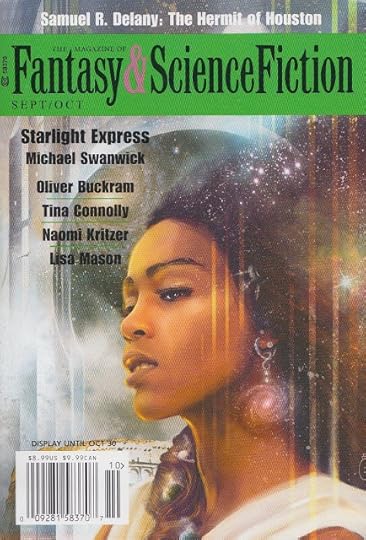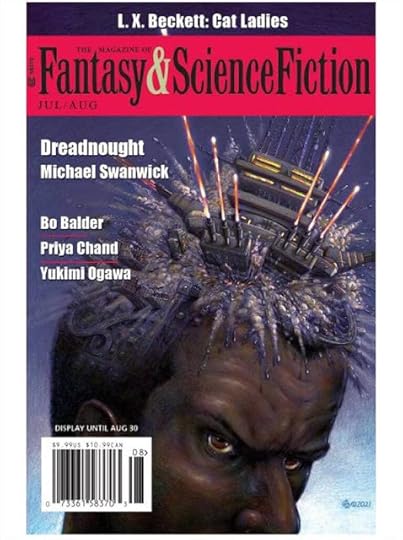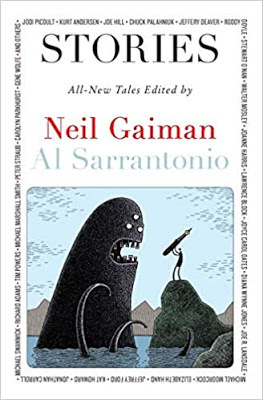Michael Swanwick's Blog, page 49
August 27, 2021
A Soft Sell for The Magazine of Fantasy & Science FIction
.

I just now renewed my subscription to The Magazine of Fantasy & Science Fiction for two years.
F&SF has a distinguished 72-year history of publishing extraordinary and often important fantasy, science fiction, and horror stories. Its run of editors includes many of the best in the genre. The latest editor, Sheree Renée Thomas is just coming into her own right now. (There is always a months-long period when an editor is publishing stories bought by her predecessor.) Among Ms. Thomas's many prior achievements are the Dark Matter anthologies documenting the previously obscured history of Black involvement in science fiction. I am a great fan of those books and am looking forward to what comes next.
Okay, I was going to give the softest of soft-sales there, but my enthusiasm ran away with me.
Anyway, I want to suggest that you consider subscribing. This is an interesting period in science fiction history and, as usual, F&SF is right in the midst of things.
You can subscribe via PayPal here, or by using a credit card here.
And have you noticed . . .??
There's a similarity in the covers I got from F&SF for my last two stories there, and it's not that both the people shown are Black.
In both, the artist (Maurizio Manzieri for "Starlight Express," above; and Alan M. Clark for "Dreadnought," below) created an image designed to draw you into the story by giving you an intriguing idea of what it's about... and then, you've read the story, inviting you to look at it again, to see how your understanding of it has changed.
They are both remarkable works, and I am fortunate to have had them attached to my stories.

*
August 24, 2021
She Saved Us From World War Three

How many feminist science fiction writers does it take to save the world?
One. Her name was Alice Sheldon and she pulled us back from thermonuclear fire before she wrote her first science fiction story.
Today is the birthday of Alice Sheldon, which is not necessarily the birthday of James Tiptree, Jr., the pen name under which she wrote some of the most scathing and brilliant stories SF has ever known. (That would be the day she lifted up a jar of Tiptree jam in a supermarket and thought: Hey, that would make a great pseudonym!) In my opinion there are two ways you can best celebrate it.
The first is by reading James Tiptree, Jr.: The Double Life of Alice B. Sheldon by Julie Phillips. I could gush about the book but, alas, I haven't the time. Suffice it to say that when, shortly after publication, I told the late editor David G. Hartwell that it was the best biography ever written about a science fiction writer, he replied, "No, it's the best biography ever written about a writer."
If you knew David, you would understand what high praise that was.
The other is by reading the Temporary Culture chapbook She Saved Us From World War Three: Gardner Dozois Remembers James Tiptree, Jr.
The chapbook contains:
1. A short but significant interview that I did with Gardner about his relationship with Sheldon/Tiptree. They were important to each other. Gardner was pretty much the first to celebrate and promote Tiptree. He was in awe of his/her work. In return, she would call him late at night when she was alone with her shotgun, contemplating suicide.
2. Henry Wessells' engaging note on the Gardner Dozois papers in the Eaton Collection at the University of California Riverside.
3. Two letters from Sheldon to Dozois. In the first, she tells him that she is not Tiptree but a woman using that persona as a mask, ending "Let me know if you're still talking to [...]" In the second, she reacts to his response with relief, calling him "a sweet & generous soul." It also, ominously in retrospect, mentions the Fox C.E. 12-gauge double barrel double choke as a youth.
4. Fold-out facsimiles of the original letters.
It's an extraordinary document and it's still available for sale for twenty dollars from Temporary Culture. As such things go, a bargain. The day it goes out of print, the price will soar. I say this as one who failed to buy limited items and shortly thereafter discovered I never would.
You can buy the chapbook here if you wish. Or just read about it and then poke about the website. It's an interesting place.
Also, don't forget about the Julie Phillips biography. It's a terrific book. When I finished reading it, I thought to myself: I now understand Alice Sheldon better than she ever did.
Oh, and since you wonder . . .
Yes, she really did save the world. But to find out how, you're going to have to read one of the above publications.
*
Remembering Rosie
.

Down the hill from where I live is a neighborhood of Philadelphia called Manayunk. The name is derived from a Leni Lenape word meaning "place where we drink," which is appropriate given how many bars there are on Main Street.
When I was new to the area, I discovered a diner on Main, its name long lost to my memory, and the place itself long lost to gentrification. It was old school: shabby, comfortable, and unpretentious, and the first thing you noticed coming in was that somebody had scrawled DROP YOUR DRAWS -- ROSIE'S BACK! on the blackboard behind the counter. Nobody ever erased those words.
The diner was presided over by Rosie. She was a vigorous old neighborhood woman who had a mouth on her. All the regulars loved her. I knew her a little because I would occasionally drop by for lunch and to keep in touch with reality.
One day, I was sitting at the counter and Rosie noticed me reading a paperback. So she came over to comment. "I don't hold with books," she said. "If you've got something to tell me, just come out and say it to my face!"
Now, I have dedicated my life to "books"--to knowledge, to literature, and specifically to fantasy and science fiction. I gave up a lot in exchange for the freedom to write. A couple of times I came close to starvation. So she was denying the validity of my entire life.
But, listening to Rosie, I had to admit that she had a point.
Above: Image taken from Philadelphianeighborhoods.com, an e-zine well worth the reading. Because if you don't know the neighborhoods, you don't know Philly.
*
August 20, 2021
L'Esprit de L'Escalier
.

L'esprit de l'escalier, or "spirit of the staircase," as you probably don't need to be told, means that moment when you're on the stairs, leaving the party, and you think of the clever thing you should have said in a conversation but didn't.
Recently, I was on a convention panel on old women in science fiction and the moderator, C. S. E. Clooney, loosening us up beforehand as a clever moderator does, posed a question: What would a thousand-year-old woman be like, compared to a hundred-year-old one? Which was an extremely good question, as witness the fact that the rest of us had no answers whatsoever. We none of us had ever thought on the matter.
Claire didn't ask the question during the live panel (thank you, Claire!), but musing on it afterwards, it occurred to me that in our relatively short lifespans we all of us suffer a great deal. We lose people we love, have health problems, do things we later regret. Someone who lived a thousand years would suffer correspondingly more. She would be a profoundly damaged individual.
But she would also have time to learn and to heal. She would have time to make herself whole again.
So I think our hypothetical thousand-year-old-human would be like a kintsugi bowl.
Kintsugi is the art of repairing broken pottery or crockery with gold. The result is a piece that highlights the damage done to the original while making it more beautiful than before.
The image of a kintsugi woman pleases me greatly. And, of course, having come up with the image, I found that someone else had beaten me to it. The above photo is taken from an article in The Tyee, written by Dorothy Woodend, which uses an art gallery installation as a jumping-off point for a meditation on kintsugi as both an art form and a more than metaphoric means of healing.
You can find the article here. It's well worth reading.
Kintsugi is a celebration of transience and fragility. So our thousand-year-old woman, formidable as she would doubtless appear to you and me, would be aware of how small she was in the face of the universe, how brief her life in the face of eternity. I think she'd be fascinating to talk with
I'm just sorry I'll never get to meet her.
*
August 14, 2021
THE LONELY AND THE RUM from Dragonstairs Press!
.

I'm posting this on Saturday, August 14. Tomorrow, Marianne's Dragonstairs Press will put its latest chapbook, The Lonely and the Rum, up on sale.
And what an eccentric document it is! The Lonely and the Rum is the lightly-edited transcript of a conversation that Greer Gilman and I (Michael Swanwick, if it needs be said) had for the Virtual Boskone earlier this year. In it, we discuss a group of fantasists who have little in common with each other, other than that they have less in common with everybody else. It's a rich, chewy appreciation of a number of fantasists who deserve your admiration.
As you can possibly tell from the photo, Marianne outdid herself with this one. It's a beautiful chapbook and one I'm delighted to own one.
It goes on sale Sunday, August 15, at noon Philadelphia time.
And here's all the pertinent information . . .
The Lonely and the Rum is a conversation between Greer Gilman and Michael Swanwick, that was part of the virtual programming for Boskone 2021. These two masters of fantasy explored the virtues and dissimilarities of the works of P. L. Travers, Stella Benson, Tove Jansson, and Sylvia Townsend Warner, among others. The only limit was the 50-minute programming cutoff. The transcript was lightly edited by Swanwick and Gilman.
Dragonstairs Press is very grateful to the staff of Boskone, for providing the original recording.
The Lonely and the Rum is 5 ¼ x 8 ½ inches, hand stitched, numbered, and signed by Gilman and Swanwick. The wrappers are silkscreened lokta paper from Nepal, with a cover illustration by Susan McAninly. It is issued in an edition of 125, of which 100 are offered for sale.
Sales will begin on Sunday, August 15, 2021, at noon, Eastern Daylight Time at www.dragonstairs.com.
Domestic: 15$
International: 18$
Above: All information taken from Dragonstairs Press's announcement.
*
July 27, 2021
Coming SOON From Dragonstairs Press!
.

Look how close Marianne is to being finished making The Lonely and the Rum for Dragonstairs Press! There in the center is number 2 of an edition of 125 hand-stitched, signed and numbered chapbooks. The paper for the wraps is beautiful as is the charming illustration made by Susan McAninley for the cover label. I think this is one of Marianne's best creations yet.
So it was pretty obnoxious of me, just now, to send Marianne the text for a totally different chapbook, which she intends to create and put up for sale before finishing The Lonely and the Rum.
Five Rings is a collection of five very short whimsies--"Gold," "Silver," "Bronze," "Last," and "Also There"--celebrating the current Olympics. Because this is officially the XXXII Olympiad, there will be only 32 copies made. Because the Olympics end on August 8 and Marianne wants the direct connection to the event, this chapbook has priority.
Fewer than thirty copies will be available for sale, I expect it to sell out pretty much immediately.
Fans of Marianne's beautifully made and scandalously affordable work will simply have to wait a little longer for The Lonely and the Rum.
And wha t, you may well ask . . .
I know you're wondering about the content of The Lonely and the Rum. It's... well, it's a little hard to describe. A few years ago, Greer Gilman and I had a panel at Boskone titled Moonwise of Babel, which was just the two of us chatting about fantasy. It went over well. A transcript of it was published in Foundation. So when Boskone went virtual this year, I proposed that Greer and I have another conversation, this one about a number of fantasists--chiefly Sylvia Townsend Warner, P. L. Travers, Stella Benson, and Tove Jansson, but others were mentioned as well--who had no particular commonalities but seemed worthy of discussion. We went into the conversation with a title, no agenda, and a great deal of curiosity to discover what we might have to say.
The Lonely and the Rum is the transcription of that two-person Zoom panel. It is a rather erudite, quintessentially odd conversation. It breaks off in the middle of an observation. And I think it's quite wonderful. There's nothing exactly like it. It is simultaneously a miniature and one of the eccentricities of our corner of the literature.
I concluded that we had found the other heart of fantasy, Greer that we had made an asterism of our subjects.
Above: Periodically, I feel I should remind everybody that I am only the content-provider for Dragonstairs Press. Marianne is the owner, editor, and sole proprietor. So being married to her is like having my editor in the same house as me. Surprisingly pleasant, to be honest.
*
July 24, 2021
Meanwhile, In Hong Kong . . .
.

Five members of a trade union for speech therapists have been arrested in Hong Kong... for conspiring to publish children's books.
This must be condemned by everyone who cares about freedom of speech and freedom of thought.
And that's all I have to say. Because what else is there to be said?
You can read the CBC article about the arrest here.
Above: This shameful image by Tyrone Siu of Reuters accompanied the Canadian Broadcasting Corporation website article.
*
July 16, 2021
Three Introductions to Three Novels by Philip K. Dick
.

Look what came in the mail! Centipede Press's boxed hardcover set of Philip K. Dick's first three novels, The Cosmic Puppets, Dr. Futurity, and Vulcan's Hammer.
By now, you're not surprised to learn that I wrote introductions to all three volumes. In fact, I wrote three different introductions, each one dealing with a different aspect of Dick's life and career. Alas, I have to inform you that by the time the books reached me, they had all sold out.
I don't think anybody here is particularly surprised about that. But if you can't buy these particular books, you can always go to their website and lust after their other creations. Centipede makes beautiful books.
To find them, click here.
Here’s the opening of the introduction to Dr. Futurity, in which I make the most outrageous statement possible about Philip K. Dick—that he was sane.
Exactly who—and what—was Philip K. Dick?
If there is one thing that all the world knows about him, it’s that he was as loopy as a box of eels. But, like so much that all the world knows, this is a myth.
I have talked with editors who worked closely with him and they tell me that Phil Dick was unfailingly professional in his dealings with them. Testimony of his friends presents him as a man who could be by turns charming or maddeningly difficult but was by no means insane. He did, in the Sixties, demonstrate erratic behavior and signs of paranoia. But that was at a time when he was taking full advantage of the many drugs, amphetamines emphatically included, available to a respectable citizen with a cooperative doctor. Stimulant psychosis is a serious matter. But it is not the same as madness.
The only authoritative evidence we have of Dick’s mental instability comes from PKD himself, and a comparison of conflicting statements from his many interviews reveals that he was, at the very least, an unreliable source of autobiographical facts.
That said, he was by no means an ordinary guy.
It was, I have to admit, lots of fun watching PKD move from short fiction to novels, learning and growing with each new volume. He was, as somebody once said, by no means an ordinary guy.
*
July 15, 2021
The Swords of Lankhmar!
.

Guess what just arrived in the mail! It's the new Centipede Press hardcover edition of The Swords of Lankhmar. This is the fifth volume of Fritz Leiber's immortal sword and sorcery series chronicling the adventures of Fafhrd and the Gray Mouser.
And I wrote the introduction!
Here's how my intro begins:
In retrospect it was a rude question for me to ask.
Authors should never be required to explain their own work. But I honestly wanted to know. And the answer I received was significant enough to merit sharing with you.
This was back in 1990, when Fritz Leiber was a guest of honor at the Philadelphia Science Fiction Conference. I found myself on an appreciation panel with the great writer sitting in a wheelchair in the front row of the audience. He was 79 years old and, quite frankly, he looked exhausted. At the time, he had less than two years yet to live.
The panelists, a mix of writers and editors, were all in awe of Leiber. Whenever one of us addressed him directly, we said “sir,” and found ourselves bowing a little, as one might to the Pope or the Dalai Lama. He was possibly the fi nest literary stylist ever to grace science fi ction and fantasy and, being people who lived by words, we couldn’t help it.
... and I went on to ask an impertinent question that got a significant answer. But to find out what Leiber said, you'll have to buy the book.
Centipede Press publishes beautifully-crafted, limited edition books and charges accordingly. A copy of The Swords of Lankhmar will set you back $75. But if you can afford it, it's money well spent.
You can find the book here. Or you can just go to their website here and fantasizing about buying one of everything just as soon as your boat comes in.

And while I'm on my soapbox . . .
If you love fantasy and fine writing and haven't yet discovered Fafhrd and the Gray Mouser, you're in for a treat. They are the gold standard of sword and sorcery (a term that Fritz Leiber invented, by the way). Witty, adventurous, colorful, fantastic, sexy... These stories have got it all.
To borrow a phrase from Harlan Ellison, Fritz Leiber could walk on water.
Sermon over. Nuff said.
*
@font-face {font-family:"Cambria Math"; panose-1:2 4 5 3 5 4 6 3 2 4; mso-font-charset:0; mso-generic-font-family:roman; mso-font-pitch:variable; mso-font-signature:3 0 0 0 1 0;}@font-face {font-family:Calibri; panose-1:2 15 5 2 2 2 4 3 2 4; mso-font-charset:0; mso-generic-font-family:swiss; mso-font-pitch:variable; mso-font-signature:-536859905 -1073732485 9 0 511 0;}p.MsoNormal, li.MsoNormal, div.MsoNormal {mso-style-unhide:no; mso-style-qformat:yes; mso-style-parent:""; margin:0in; mso-pagination:widow-orphan; font-size:12.0pt; font-family:"Calibri",sans-serif; mso-ascii-font-family:Calibri; mso-ascii-theme-font:minor-latin; mso-fareast-font-family:Calibri; mso-fareast-theme-font:minor-latin; mso-hansi-font-family:Calibri; mso-hansi-theme-font:minor-latin; mso-bidi-font-family:"Times New Roman"; mso-bidi-theme-font:minor-bidi;}.MsoChpDefault {mso-style-type:export-only; mso-default-props:yes; font-family:"Calibri",sans-serif; mso-ascii-font-family:Calibri; mso-ascii-theme-font:minor-latin; mso-fareast-font-family:Calibri; mso-fareast-theme-font:minor-latin; mso-hansi-font-family:Calibri; mso-hansi-theme-font:minor-latin; mso-bidi-font-family:"Times New Roman"; mso-bidi-theme-font:minor-bidi;}div.WordSection1 {page:WordSection1;}
July 12, 2021
A Letter from the Author: About "Goblin Lake"
.0

About a month and a half ago, I was interviewed by Luba Lapina for the Sunrise Literature Discussion Club in Moscow. It is their practice to read a suitable story, discuss it, and then (after obtaining permission to do so) asking the author five questions about it.
The story they chose was my "Goblin Lake" and I thought their questions astute enough that I've decided to share my response to them.
Enjoy!
Dear Luba Lapina,
What interesting sessions the Sunrise Literature Discussion Club has! I write under the assumption that my readers are intelligent and perceptive people who will have no trouble understanding my stories. So it’s pleasant to see this proved out in real life.
Let me preface my comments by observing, as I’m sure others have before me, that I can only tell you my intentions, not what the story is or means. Once a work of fiction is finished, it no longer belongs to the author but to whomever is currently reading it. My interpretation may or may not be as valid as anybody else’s.
That said, in your first question, you ask why Jack made the choice he did.
I wrote “Goblin Lake” because I wanted to tackle the great central theme of fantasy—the reconciliation of reality and imagination. The worlds of our imagination are (or can be) superior to reality in all ways but one: the fact that they don’t exist. So when I gave Jack the choice between the two, it was only fair to let him see the virtues of fantasy and the drawbacks of reality. Then I let him make up his own mind.
I could not tell you why Jack chose as he did. His thinking was as opaque to me as it was to the reader. But I had a practical reason for dictating his choice, which was that opting for immortality in a world of beauty and comfort wouldn’t have been a very interesting ending to the story. Behind that was an artistic reason, which was that his choosing the world as it is, in all its difficulty and discomfort, brings its readers to a very interesting place where they have to ask, as you did, why? Is this imperfect life truly worth celebrating? Do we let its pains and tragedies blind us to its wonders? Does mere existence justify a life that may not satisfy us? These are difficult questions and I did not want to impose answers upon them. But I very much wanted to make the reader think about them.
It’s also possible to read the ending as Jack choosing the freedom of life over the predetermination of literature. Which leads me to your second question. You asked whether we all live inside a story, whether I believe in destiny or predetermination, and whether we can exist simultaneously in parallel universes, being good in one and bad in the other.
The central issue cuts close to the bone for me. I was raised in the Catholic faith—when I was young, I intended to become a priest—and free will is a central tenet in Catholicism. So I grew up with a horror of predetermination. Reducing life to a sequence of robotic non-decisions seemed the most terrible thing imaginable. What resolved the problem for me was the invention of chaos theory. If all complex actions have unpredictable results, then the concepts of free will and predetermination are rendered meaningless. The distinction simply goes away. I found that very liberating.
I don’t think that we live in a story for the simple reason that life doesn’t have the shapeliness and consistency that good fiction has. And I don’t believe in parallel universes because the concept seems inherently wasteful, whereas the laws of the universe as we understand them are elegant and parsimonious. But in both of these matters, as in so many other things, I could be wrong.
Addressing the third question, I have had the same experience as Tamila of projecting myself into brightly-colored book illustrations as a child. That’s not where the story came from, though it’s closely related. Almost all of us have had the experience of “falling into” a book—losing sight of the fact that we’re reading and experiencing the imaginary world as a real place. I wanted to give an imaginary character the chance to fall out of a book.
In fact, I did not put Jack inside the book. I found him already there. Which is why, to answer your fourth question, the story is set where and when it is. During the Thirty Years War, a ten-year-old boy was kidnapped by Hessian soldiers to be their servant. Hans Jakob Christoffel von Grimmelshausen (this is probably a pseudonym) grew up to be first a musketeer and then an aide to his commanding officer. After the war, he held various civilian occupations, eventually becoming a magistrate. This gave him the leisure to devote himself to literature, including Simplicius Simplicissimus which is considered to be the finest German novel of the seventeenth century. It is a picaresque novel, in which a simple young man is kidnapped by soldiers, becomes a soldier himself, and experiences every occupation available to a man of his times: raider, doctor, courtier, lover, and so on and so on. It was witty, sharply satirical, and enormous fun to read.
Simplicissimus was so great a hit that somebody pirated the book, wrote new chapters extending its plot, and sold the book as his own. Von Grimmelshausen then took the pirated book, added yet more chapters of his own, and re-published it—without removing the chapters he hadn’t written. Every writer who knows this story loves him for doing that. It also means—but if this did not bother the author, why should it bother us?—that he may not have written the section, the only example of fantasy in the book, in which his hero goes to live beneath the Mummelsee.
Von Grimmelshausen knew the reality of war from first-hand experience. Yet from those horrors he crafted a delightful work of the imagination. So, again, we are confronted with the relationship of fiction and reality.
Finally, you asked about the Mummelsee’s statement that “One miracle is enough for any life”—why only one, what can be said to be a miracle, and how many miracles per life are enough.
A miracle is something that, by the nature of the universe, you cannot have, no matter how much you desire it. There have been wondrous moments in my life that felt like miracles—the birth of my son, the moment when Marianne and I were declared married, a flash of religious ecstasy when I was a boy. But nothing forbids such moments.
It sounds banal to say it aloud, but simply being alive is a miracle. Even if, as I believe, life is common in the universe, intelligent life has to be extraordinarily rare. During conception, hundreds of millions of sperms compete for a single egg. The odds of you simply being here are statistically indistinguishable from a miracle. I try to remember that when I’m feeling grouchy.
One miracle per lifetime is, I’m afraid, all we get. But it’s enough.
Which finishes my responses to the questions you posed. But I will throw in the answer to a sixth question you could not have known to ask. This is something I’ve never told anybody but my wife before now. I named the protagonist Johann/Jürgen/Jack as a kind of memorial to my younger brother Jack, who was killed by a drunken hit-and-run driver in Florida in the early 1980s. Since he no longer has a place in reality, I gave him one in fantasy, where he need never die and can live whatever life he chooses. That it is not possible to restore Jack to life in the real world is yet another way that reality is inferior to fantasy. Yet I dearly wish I could. Perhaps that is the true answer to your first question.
Thank you for letting me discuss my story with you. I wish you all a long life and many books.
All best,
Michael Swanwick
Above: "Goblin Lake" originally appeared in Stories, edited by Neil Gaiman and Al Sarrantonio. A noble book and one that is well worth your seeking out.
*
@font-face {font-family:"Cambria Math"; panose-1:2 4 5 3 5 4 6 3 2 4; mso-font-charset:0; mso-generic-font-family:roman; mso-font-pitch:variable; mso-font-signature:-536870145 1107305727 0 0 415 0;}@font-face {font-family:Calibri; panose-1:2 15 5 2 2 2 4 3 2 4; mso-font-charset:0; mso-generic-font-family:swiss; mso-font-pitch:variable; mso-font-signature:-536859905 -1073732485 9 0 511 0;}p.MsoNormal, li.MsoNormal, div.MsoNormal {mso-style-unhide:no; mso-style-qformat:yes; mso-style-parent:""; margin:0in; mso-pagination:widow-orphan; font-size:12.0pt; font-family:"Calibri",sans-serif; mso-ascii-font-family:Calibri; mso-ascii-theme-font:minor-latin; mso-fareast-font-family:Calibri; mso-fareast-theme-font:minor-latin; mso-hansi-font-family:Calibri; mso-hansi-theme-font:minor-latin; mso-bidi-font-family:"Times New Roman"; mso-bidi-theme-font:minor-bidi;}.MsoChpDefault {mso-style-type:export-only; mso-default-props:yes; font-family:"Calibri",sans-serif; mso-ascii-font-family:Calibri; mso-ascii-theme-font:minor-latin; mso-fareast-font-family:Calibri; mso-fareast-theme-font:minor-latin; mso-hansi-font-family:Calibri; mso-hansi-theme-font:minor-latin; mso-bidi-font-family:"Times New Roman"; mso-bidi-theme-font:minor-bidi;}div.WordSection1 {page:WordSection1;}
Michael Swanwick's Blog
- Michael Swanwick's profile
- 546 followers



